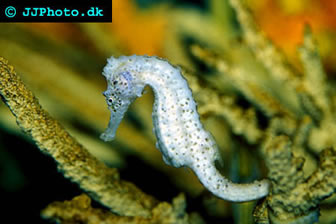Long Snout Seahorse
Hippocampus reidi

Hippocampus reidi is known under several different common names in English, including Long Snout Seahorse, Longsnout Seahorse, Slender Seahorse and Great Brazilian Seahorse. Just like all the other seahorses, it belongs to the family Syngnathidae.
Conservational status
Hippocampus reidi is listed as “Data deficient (DD)” in the IUCN Red List of Threatened Species. In 1996, Hippocampus reidi was listed as “Vulnerable (VU)” under the 1994 criteria, but when the species was reassessed under new criteria and with greater taxonomic understanding, the IUCN found that that no appropriate data on biology and ecology, habitat, abundance or distribution were available for this species. It was therefore listed as “Data deficient (DD)”. The last time it was assessed was in 2003.
Hippocampus reidi is considered threatened in the United States by the American Fisheries Society (AFS).
Hippocampus reidi is collected for the aquarium trade, to be used in traditional folk medicines, to become souvenirs, and for religious purposes. The species is also taken as a bycatch by shrimp trawl fisheries. The international trade is monitored through a licensing system; the entire genus Hippocampus was listed in Appendix II of CITES in November 2002.
Geographical distribution, habitat and habits
The Long Snout Seahorse is found in the Western Atlantic, from North Carolina in USA to Santa Catarina in Brazil. It has been found in the waters of Bahamas, Barbados, Belize, Bermuda, Brazil, Colombia, Cuba, Grenada, Haiti, Jamaica, Panama, and United States (Florida and North Carolina), and Venezuela. It is uncommon in most parts of its geographical range, but quite common in a few limited areas.
The Long Snout Seahorse has been encountered down to a depth of 55 meters / 180 feet in the ocean. Small specimens tend to prefer more shallow waters than their larger counterparts. This species can be found in marine and brackish environments.
The Long Snout Seahorse spends most of its time attached to something, e.g. to gorgonians, seagrass, mangrove or floating Sargassum. It can also be seen swimming freely in midwater. The Long Snout Seahorse is not a migratory species and it likes to stay put in one spot. It is not a powerful swimmer; it moves very slowly in the water.
Size and appearance
The largest scientifically measured Long Snout Seahorse was 17.5 cm / 6.89 in from the top of the coronet to the tip of its straightened tail. It has a broad, almost double cheek and the snout is long and thick. The body is narrow, usually without any skin appendages.
The colours of a Long Snout Seahorse can be red, saffron, buttercup, ochre or mustard yellow. The body is often decorated with numerous dark spots. White dots may also be seen, especially on the tail. Some specimens have pale “saddles”.
Long Snout Seahorse care
The Long Snout Seahorse is a peaceful species and is considered reef safe. It is best kept in pairs. If the aquarium is large enough, you can keep several pairs together. The pairs will get along well with small and friendly fishes, e.g. firefish and ocellaris. Keeping seahorses with aggressive fish or fish that will force them to compete for food is not a good idea.
Avoid keeping Long Snout Seahorse in aquariums smaller than 30 gallons / 115 litres. Since this is an upright creature, the height of the aquarium is actually more important than the exact volume and it is best to use an aquarium that is at least 16 in / 40 cm tall. The taller the aquarium, the better.
The recommended water temperature is 72-78º F / 22-25.5º C. The specific gravity should be kept in the 1.020-1.025 interval and the pH-value between 8.1 and 8.4.
Feeding Long Snout Seahorse
The Long Snout Seahorse is a carnivore creature and you should be prepared to provide it with live food in the aquarium. It is usually possible to train a Long Snout Seahorse to accept frozen meaty foods, but it can take some time and the seahorse needs to be provided with live food during the learning process to avoid starvation. It is important to keep the diet varied and nutritious. You can for instance give your seahorse amphipods, grass shrimp, ghost shrimp and brine shrimp. This species eat most types of small crustaceans. It is a slow feeder and it should not be forced to compete for food with faster or more assertive species in the aquarium. Give your seahorse many small servings of food throughout the day instead of just one or two big ones.
Breeding Long Snout Seahorse
The Long Snout Seahorse is an egg-laying species and the male will carry the eggs inside a brood pouch located under his tail.
The Long Snout Seahorse is a monogamous species and once a pair has been formed the two partners will typically stay together until one of them dies. The female can produce up to 1600 eggs per spawning. The birth will typically take place 14 days after fertilization.
When a Long Snout Seahorse pair is kept in a suitable aquarium where they are well cared for and provided with a suitable diet, they can breed year round and produce new offspring every second week.
Seahorse Articles:
Sea horses in Aquarium - An article about how to keep sea horses in aquariums.Lined Seahorse – A guide to keeping Hippocampus erectus
Common Seahorse – A guide to keeping Hippocampus kuda
